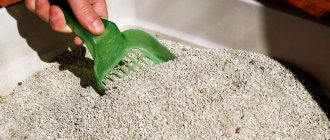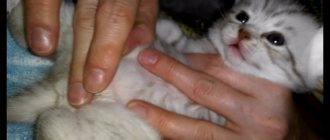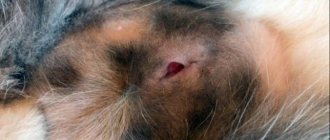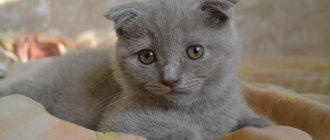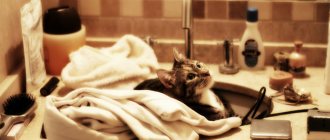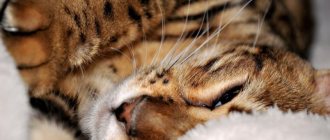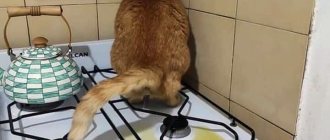Frequent urination in cats is called pollakiuria in veterinary medicine and can occur for a variety of reasons. This is a rather unpleasant condition, in which the main thing is to contact a veterinarian at the first sign in order to treat your pet as effectively as possible. Positive dynamics can only be achieved with an integrated approach, but if this condition is prolonged, then in the future there may be a lack of urination, which can lead to the death of the cat. In our article we will tell you why and under what diagnoses this condition can occur in cats, and how to treat it.
Causes of the disease
Urine excretion is a necessary physiological process through which metabolic products are removed from the body. A pathological condition in which a cat pees more often than usual indicates a malfunction of the urinary system and is called pollakiuria in veterinary medicine.
This term refers to excessively frequent urine output that goes beyond the cat’s daily norm while maintaining a normal volume. Pollakiuria is not an independent disease, but a harbinger of diseases of various organs and systems.
Pathological causes of frequent urination include:
- cystitis;
- urolithiasis disease;
- diabetes;
- urinary tract infections;
- renal and liver failure;
- prostatitis;
- bakvaginitis (in cats);
- malignant and benign tumors, due to which compression of the bladder occurs and its mechanical emptying;
- central diabetes insipidus;
- purulent inflammation of the uterus (pyometra);
- hyperthyroidism;
- Cushing's syndrome;
- kidney pathologies (nephrosis, amyloidosis);
- urinary incontinence;
- Addison's disease.
Often, a cat pees more often than usual due to stressful situations that he has had to endure.
A change of place of residence, the appearance of another pet in the house, noisy companies, and even a regular car trip to the veterinary clinic can negatively affect the animal’s psyche and lead to a reflex contraction of the bladder. When the cat calms down, he will go to the litter box as before.
Another factor in frequent urination is when cats reach a certain age when they begin to become sexually active. Leaving marks is normal and has nothing to do with illness. In this way, the cat shows that he is the master of his territory.
Other signs that trigger urine leakage include old age, extreme thirst, hypothermia, and taking certain medications (anticonvulsants, cortisone, diuretics, etc.).
Why does my cat urinate often?
Frequent urination, or scientifically called pollakiuria, in a cat can occur for various reasons.
The symptom of frequent urination in a cat almost always indicates serious health problems. Some of them are easy to correct and treat, but there are also those that can lead to the death of the cat. When assessing whether a cat is urinating frequently, one must assume that it is normal for a cat to urinate up to three times a day.
The reasons for frequent urination in a cat can be both physiological and pathological.
To frequent urination in cats
The following physiological reasons may be given::
- Stress. When moving to a new place of residence, a cat may experience severe nervous shock, as a result of which the cat experiences a reflex contraction of the bladder. A noisy campaign or a trip to the veterinary clinic also causes stress in the cat.
- Mating period. During this period, male cats begin to mark their territory with a small amount of unpleasant smelling urine. Additionally, during this period, the behavior of male cats changes dramatically - they become very restless, twitch their tails, and scream loudly (estrus in cats).
- Elderly age. As cats age, the bladder sphincter weakens.
- Intense thirst. When a cat drinks a lot, it urinates a lot. At the same time, severe thirst is often one of the symptoms of diabetes in a cat.
- Taking certain medications (diuretics, cortisone, anticonvulsants, etc.)
- In winter, when the cat is very cold, frequent urination will be the norm for him.
Pathological reasons that cause frequent urination in a cat:
Cystitis . Cystitis is an inflammation of the mucous membrane of the bladder, as a result of the presence of an infection in the bladder or mechanical damage to the mucous membrane from urinary stones.
Etiology. Most often, this disease occurs as a result of prolonged hypothermia. This usually occurs in those cats that like to sleep on the windowsill with the window open or near the door (in places where there is active air movement). As a result of complications in diseases of the genitourinary system: pyelonephritis, urolithiasis, damage to the urinary tract by parasites. The presence of both internal and external parasites in the cat (fleas, ticks, lice eaters and helminths). Parasites cause mechanical damage in cats in the area of the external genitalia, and given that the cat’s anus and urethra are almost very close, and when the cat begins to lick, the infection is carried through the urethra into the bladder. Additionally, parasites will release toxins that lead to metabolic disorders and the occurrence of secondary cystitis. The cause of cystitis, which is difficult to treat, can be such widespread infectious diseases in cats as calcevirus infection, chlamydia, and rhinotracheitis. These infectious diseases are chronic and have a carrier form. Mechanical damage to the urethra.
Clinical picture. The cat has a frequent urge to urinate (the cat often sits on the tray or in another place). Sometimes after visiting the litter box, the cat crawls out of it on half-bent legs. We note frequent urination in small portions (sometimes a few drops). When urinating, the cat experiences anxiety and pain. At the end of the act, the cat sometimes makes plaintive sounds. The smell of urine becomes pungent, ammonia-like or purulent. Mucus, crystals, blood, and pus appear in the urine. Sometimes there is a lack of urination. Due to pain in the abdominal area, the cat very carefully turns over from one side to the other. The cat begins to refuse food, becomes thirsty, drinks a lot, and becomes lethargic and apathetic. An unreasonable increase in body temperature (above 39°C) appears. The abdomen upon palpation is very painful, tense and tight, and does not allow touching the abdomen. In severe cases, the cat may vomit (vomiting in a cat), swelling of the limbs, collapse and coma.
During laboratory examination of urine, depending on the severity of the inflammatory process, protein, mucus, epithelium, leukocytes, red blood cells, pus, blood, and salt crystals may be present in the urine. During bacteriological examination, pathogenic microflora is isolated (Escherichia coli, cocci, streptococci, Pseudomonas aeruginosa, chlamydia, etc.).
The diagnosis of cystitis is made on the basis of anamnesis, clinical signs of the disease, results of laboratory tests of urine, clinical and biochemical blood tests, results of cytoscopy, results of an ultrasound examination of the abdominal cavity, results of an X-ray examination of the abdominal cavity. If cystitis of infectious etiology is suspected, appropriate laboratory tests are performed. In case of severe cystitis in a cat, the clinic’s veterinarian sometimes has to resort to double-contrast cystography or excretory urography.
Treatment. In each specific case, the clinic’s veterinarian prescribes treatment depending on the type of cystitis, general condition, and the presence or absence of urethral or ureteral obstruction in the sick cat. Read more about the treatment and prevention of cystitis in our article (cystitis in cats).
Urolithiasis disease . Urolithiasis is a chronic disease of cats in which stones and urinary sand (urolithiasis) form in the urinary tract of animals.
Causes of urolithiasis. Urolithiasis in cats can be caused by two groups of causes, both exogenous (external) and endogenous (internal) origin.
Veterinary specialists include endogenous causes: the anatomical features of the cat’s urinary tract. The urethra is quite narrow, which leads to turbulence in the flow of urine, changing its physical and chemical properties and contributes to the loss of mineral deposits in the urine, from which sand and urinary stones can form. When a cat is castrated early, the urinary canal takes on an S-shape, in which urine is often retained, causing urolithiasis.
One of the causes of urolithiasis may be a violation of the hormonal regulation of calcium and phosphorus metabolism by the parathyroid gland, the hormones of which (parathyroid hormone and calcitonin) affect the content of calcium and phosphorus ions in the blood and, accordingly, in the urine.
In diseases of the gastrointestinal tract (gastritis, enterocolitis), a violation of the acid-base balance occurs due to impaired absorption of nutrients, calcium is retained in the animal’s body. The appearance of kidney stones is promoted by various infectious diseases of the urinary tract and the kidneys themselves.
Obesity in a cat also leads to the formation of urinary stones.
Exogenous causes. Of the exogenous causes, the greatest influence on the occurrence of urolithiasis is the diet that the cat eats. Especially when the diet contains a lot of proteins that are rich in nucleic acids. During the metabolism of proteins in the cat’s body, urea is formed, and during the breakdown of nucleic acids, uric acid is formed. When you overfeed your cat with protein foods, a large concentration of urea and uric acid accumulates in the body. Which in turn contributes to the formation of sand and urinary stones in the kidneys. Urinary disease in a cat can be caused by an increased content of mineral substances in the food consumed when owners feed their cat dry food and canned food, which leads to a lack of vitamin B6 in the body. The formation of kidney stones is greatly influenced by a lack of vitamin A in the diet, as a result of which the cat develops hypovitaminosis A. Pet owners should know that vitamin A is found in large quantities in fish oil, chicken egg yolks, caviar, butter, and other dairy products.
Exogenous causes of urolithiasis in cats include the mineral composition of water and soil, especially the content of calcium salts in it. If your cat drinks such hypercalcified water, then an increased concentration of calcium will form in his urine, which in turn can lead to the formation of calculi in the kidneys. If you live in a region with a hot climate, then your cat will release excess water from the body when breathing from the lungs, with a decrease in the amount of urine excreted by the kidneys. In this case, urine becomes very concentrated, which also contributes to the formation of kidney stones.
Symptoms of the disease. If a cat’s kidney stones are small and there is no blockage of the urinary tract, then the cat’s disease occurs without obvious clinical signs, but the results of laboratory tests of urine and blood indicate its occurrence. During such a latent period in the course of urolithiasis, symptoms can be detected in a cat that not only indicate its development, but also allow a veterinarian to determine the location of the urolithiasis. The cat's owners notice a decrease in appetite, drowsiness, and depression.
When a stone forms in the renal pelvis, a cat develops symptoms characteristic of pyelitis. Owners sometimes find blood in their cat's urine (hematuria), especially after active movements of the cat. The presence of stones in the cat's bladder is manifested by frequent urge to urinate and restlessness. In the case when a kidney stone begins to move along the ureter and causes its blockage, we observe ureteral obstruction. With partial obstruction of the ureters, owners note difficulty urinating in the cat. Urination becomes strained, and the cat sometimes cries during toileting. The cat's urination becomes frequent with the release of a small amount of urine; upon careful examination, blood can be detected in the urine. Additionally, the cat's owners note a lack of appetite, vomiting, and the abdominal area becomes painful upon palpation.
In the chronic course of the disease, the cat may develop a chronic urinary tract infection - chlamydia, mycoplasmosis.
Diagnosis, differential diagnosis, treatment and prevention are outlined in the article - kidney stones in cats - urolithiasis.
Diabetes . Diabetes mellitus is a clinical syndrome caused by absolute or relative deficiency of insulin, characterized by chronic hyperglycemia with the development of decompensation of all types of metabolism, both acute and chronic.
Causes of diabetes. Diabetes mellitus in cats occurs as a result of insufficient production of insulin by the beta cells of the pancreatic islets of the pancreas, or when there is a malfunction in the body when the hormone insulin produced goes unnoticed by target cells. As a result, the cat's blood glucose levels rise sharply. In a cat’s body, the activity of almost all organs and tissues is disrupted.
Specific reasons leading to this condition in an animal include the following factors:
Irregularities in feeding cats, namely feeding an unbalanced diet in terms of basic nutrients, vitamins and macro-microelements, causing metabolic disorders in the body.
Diseases of the gastrointestinal tract (gastroenteritis in cats, flatulence in cats, etc.) cause increased load on the pancreas and ultimately provoke diabetes in the cat.
Chronic liver diseases (liver disease in cats), gallbladder diseases (cholecystitis in cats) are also contributing factors in the development of diabetes in a cat.
Obesity as a result of systematic overfeeding.
Hereditary predisposition (as in humans).
Infectious diseases (calcivirus infection of cats, panleukopenia of cats, chlamydia of cats, salmonellosis in cats).
Invasive diseases (toxoplasmosis in cats, worms in cats).
The use of hormonal drugs to control sexual behavior. Stress (leads to overexcitation of the central nervous system, and through it to disturbances in the functioning of the animal’s endocrine system.
Clinical picture. The clinical picture of diabetes mellitus in cats mainly depends on the type of diabetes mellitus. With the first type (absolute insulin deficiency), the owners note increased thirst in the cat, which is a consequence of the high concentration of glucose in the animal’s blood. The cat’s available insulin is not enough to absorb glucose, the excretory system is not able to process the sugar in the blood and it appears in the urine. The amount of daily urine in a cat increases (polyuria), due to which, as a result of increased thirst, the cat drinks a lot of water. A cat's urination is painless. The cat's appetite changes; it can either increase or decrease. Body weight increases in diabetes mellitus. Upon clinical examination, such a cat has dull fur and constantly sheds (why does a cat shed: possible reasons). Owners note that the cat has digestive disorders - vomiting (vomiting in cats), diarrhea (diarrhea in cats), cardiovascular system - tachycardia appears (increased heart rate). The cat becomes lethargic, develops weakness, and its gait becomes unsteady and uncertain. When a cat develops intoxication, a strong smell of acetone begins to emanate from it, and not only urine and skin smell, the smell can come from the oral cavity (bad breath in a cat). In advanced cases of diabetes, the cat may experience seizures, fainting, and loss of consciousness.
With the second type of diabetes, owners notice an increased appetite in the cat, and as a result, the cat quickly gains weight and becomes obese. The cat constantly drinks a lot of water, and frequent, painless urination appears. The general condition of a sick cat upon clinical examination is usually satisfactory. Unlike type 1 diabetes, the cat does not smell of acetone.
Diagnosis, differential diagnosis, treatment and prevention are outlined in our article - diabetes mellitus in a cat.
Infectious diseases affecting the genitourinary tract (feline chlamydia, mycoplasmosis in cats).
Prostatitis . Prostatitis is inflammation of the prostate gland. It occurs in cats in acute or chronic form. Prostatitis occurs due to the penetration and impact of pathogenic microorganisms and protozoa on the prostate tissue, primarily staphylococci, streptococci, Proteus, Escherichia coli and Pseudomonas aeruginosa, vibrio, trichomonas and chlamydia.
Prostatitis clinic. Discharge from the penis (clear, cloudy, yellow or bloody). Difficulty defecating, lethargy, lack of appetite, weight loss, increased body temperature, bloating, difficulty urinating, infertility in cats.
Pyometra. Pyometra is an accumulation of purulent exudate in the uterine cavity of a cat.
Causes of pyometra in cats. The appearance of pyometra in a cat can be provoked by a number of factors: trauma during childbirth, childbirth in non-sterile conditions, in violation of the rules of asepsis and antiseptics. Hormonal dysfunction of the ovaries. It develops in cats due to high levels of progesterone and estrogens in the cat’s body; it can develop when taking drugs for estrus (contrasex, anti-sex), etc. With hormonal dysfunction, a cat develops glandular-cystic endometrial hyperplasia, accompanied by the appearance of cysts. The body's defenses are weakened and the cat eventually develops pyometra. Inflammation of the genitourinary system (cystitis, vaginitis, cervicitis, endometritis), in which the inflammatory process from the lower parts of the reproductive system enters the uterine cavity. Uncontrolled matings, matings with an untested cat. Infectious and invasive diseases, the causative agents of which affect the cat’s endometrium (chlamydia in cats, mycoplasmosis).
Signs of pyometra. Pyometra in cats can be open or closed. With an open pyometra, the cervical canal is open and pink or brown purulent contents are discharged from the vulva in large quantities. After lying down, the cat leaves whitish spots on the litter, and body temperature increases by 1 -1.5 ° C. A sick cat develops increased thirst, complete and partial loss of appetite, gastrointestinal upset (diarrhea in cats), and frequent urination. The cat licks its genitals every 20-30 minutes.
With a closed pyometra, upon external examination there is no vaginal discharge because the cervix is closed. In the uterine cavity, purulent exudate accumulates, causing intoxication of the body. Body temperature rises by 1-2°C, the cat has no discharge from the external genitalia, thirst increases greatly, appetite disappears, and the general condition quickly deteriorates. The activity of the gastrointestinal tract is disrupted - diarrhea appears. Damage to the genitourinary system is accompanied by frequent urination. On palpation, the cat's abdomen is enlarged and tight. The cat develops intoxication of the body, breathing becomes heavy, and there is no reaction to external stimuli. In some cats, the development of pyometra can occur very rapidly, and the cat may die before the onset of symptoms of the disease characteristic of pyometra. The amount of purulent exudate in the uterine cavity can reach a liter in two days; the thin layers of the uterus cannot withstand the pressure, and pus escapes into the abdominal cavity with the development of purulent peritonitis. Diagnosis, treatment and prevention in the article - pyometra in a cat.
Urinary incontinence . Urinary incontinence (enuresis) in cats can be more or less pronounced for its owners.
Types of urinary incontinence in cats: Leaking or dripping of urine. This incontinence in a cat is accompanied by the leakage of urine in small quantities, sometimes in the form of a few drops. It is sometimes quite difficult for an owner to identify such a disorder in a cat and it does not always occur to them that the discovery of small wet spots on the carpet, bedding or floor is associated with urinary incontinence in your pet.
Constant or regular leakage of urine. With this type of incontinence, cat owners note that urine leaks out not only in an active state, but also when the cat is resting. With this type of incontinence, urine constantly leaks onto the floor, carpet, etc. as the bladder fills. and the cat is not always able to run to the tray when he feels another urge to urinate. That is, the cat reaches a state when he is unable to control the process of urination.
Urgeal incontinence. With this type of disorder, a fairly large amount of urine is released. Urgeal incontinence in cats is characterized by the fact that this process occurs unexpectedly, both for the cat itself and for its owner. At the same time, the cat with all its appearance tells the owner that this “accident” happened unexpectedly for him. Therefore, owners should not punish him for this.
Stress urinary incontinence. In a state of severe stress, even the healthiest and most well-mannered cat (like a person) can suddenly wet itself out of fear and unexpected nervous experiences. In the future, your cat, under normal circumstances, will no longer repeat such an action, unless it is not exposed to similar stressful situations.
What are the causes of urinary incontinence in cats? Let's look at the reasons why your pet may suffer from a similar illness that is undesirable for its owners. Congenital pathological changes in the genitourinary system. With this pathology, your kitten from birth is not able to control the processes of urination using its central nervous system. As a result, kitten owners, having failed to train them to use a litter box, send them outside. At the same time, a highly qualified clinic doctor can determine more accurately whether there is a congenital pathology using an ultrasound examination.
The presence of infectious diseases in the cat (mycoplasmosis in cats). Often, certain infectious diseases in a cat cause certain problems with urination in the animal, ultimately leading to urinary incontinence. However, it may not necessarily be only kidney damage. There may be general damage to the entire body, for example: feline panleukopenia, cystitis in cats, urocystitis in cats, nephritis, nephrosis, etc.
In recent years, among the cat family, often as a result of improper feeding (the use of cheap low-quality food and as a result of mixing dry and natural food), cases of urolithiasis in cats have increased many times over. In which one of the symptoms in your pets may be urinary incontinence.
Certain malfunctions in the functioning of the central nervous system that occur in cats as a result of an infectious disease, injuries and bruises of the spine, inflammatory processes in the brain itself, etc.
Metabolic disorders in the animal's body. As a result of metabolic disorders, the cat experiences weight gain, diabetes develops (diabetes mellitus in animals, diabetes insipidus in animals), and disorders associated with the urinary system occur, including. urinary incontinence.
Age-related changes. As a cat's body ages, it may experience certain disruptions. The cat is sometimes unable to control the functioning of its urinary system, resulting in litter, floor, etc. puddles or droplets of urine may appear.
Childbirth in a cat. In the case when, at the time of contractions and pushing, the cat’s bladder is full, the cat may experience uncontrolled spontaneous urination. In this case, the owners of the animal simply need to change the cat’s bedding.
The cause of urinary incontinence in a cat can be paresis, paralysis, bladder spasm, tumors and trauma. All of the above reasons, with your help, can only be determined by a highly qualified veterinary specialist at the clinic. Therefore, if you notice certain abnormalities in the functioning of the genitourinary system in your pet, you need to contact your veterinary clinic. For diagnosis, treatment and prevention of urinary incontinence, see our article - urinary incontinence in cats.
Malignant and benign tumors of the genitourinary organs ( oncology in cats ).
Cushing's syndrome. This syndrome is an extremely rare pathology in which a cat's adrenal glands produce excessive amounts of cortisol.
An excess of this hormone in a cat’s body causes the cat to constantly drink and urinate. At the same time, the cat develops a beastly appetite, but its body weight remains the same, although its belly grows. Over time, the cat loses mobility, the muscles become weak and flabby. Changes occur in the fur, which becomes thin and brittle; as a result, with minor mechanical stress, deep cracks and abrasions form in the cat.
Diagnostics. In order to make a correct diagnosis of why a cat often urinates, the clinic’s veterinarian, in addition to collecting a history of the disease and conducting a clinical examination of the cat, will need to conduct additional studies:
- Blood and urine analysis.
- Ultrasound of the kidneys, bladder and abdominal organs.
- Radiography.
- Test for hormonal antidiuretic complex.
- If a bacterial infection is suspected, culture on nutrient media.
Treatment . After diagnosis, the clinic’s veterinary specialists will provide treatment aimed at the underlying disease causing frequent urination in the cat.
So, for diabetes mellitus, veterinary specialists will prescribe insulin therapy.
If your cat's frequent urination is caused by stress, then first of all we eliminate the source of stress and prescribe sedatives (Stop-Stress).
For other diseases, see treatment in our articles.
Prevention. Prevention of frequent urination in a cat should be based on compliance with nutritional rules of prevention:
- Balanced feeding.
- Obesity prevention.
- Strong physical activity and active games.
- For drinking, use filtered or bottled water.
- Do not allow your cat to become hypothermic, both in the apartment and during walks.
Regularly treat for worms and vaccinate against infectious diseases that occur in your region.
Main symptoms
Signs of urinary dysfunction are visible to the naked eye: the cat pees more often than usual. If the volume of daily urine excretion is exceeded, then we are no longer talking about pollakiuria, but about polyuria. This can be understood by the litter in the cat's litter box.
For example, if you used to change it once a week, and recently - 2-3 times a week, it means that a serious failure has occurred in the cat’s body. For reference: the normal volume of urine excreted in an adult cat is on average 28 ml (about half a tea cup) for 2-3 visits to the litter box per day.
Frequent urination may be accompanied by other signs - increased thirst, discharge of blood and pus along with urine, fever, weight loss. Due to frequent urination, the water-salt balance is disturbed and the appearance of the pet worsens.
The fur on the hind legs, belly, and lower part of the tail is constantly wet, emitting an unpleasant odor. For cats, which are naturally very clean animals, this causes considerable discomfort, forcing them to constantly lick themselves.
It is worth observing the cat's condition. Perhaps the dry food is too salty or she has eaten too much of it. If pollakiuria is associated specifically with the diet, then within a day urination will normalize.
Video “Cat cystitis”
In the video you will see how a doctor diagnoses and treats cystitis in a cat.
Sorry, there are no surveys available at this time.
Was this article helpful?
Thank you for your opinion!
The article was useful. Please share the information with your friends.
Yes (66.67%)
No (33.33%)
X
Please write what is wrong and leave recommendations on the article
Cancel reply
Rate the benefit of the article: Rate the author ( 7 votes, average: 4.57 out of 5)
Discuss the article:
Diagnostics in a veterinary clinic
To make a correct diagnosis, a veterinarian needs to conduct the necessary diagnostic tests. After a visual examination of the animal and collection of anamnesis, the specialist prescribes for the cat:
- blood and urine tests;
- Ultrasound of the kidneys, bladder, abdominal cavity;
- radiography;
- seeding on nutrient media (in case of possible bacterial infection);
- studies on the hormonal antidiuretic complex.
When conducting diagnostics, the veterinarian excludes factors such as increased salt intake, medications, and infusion therapy.
So, how often do kittens pee?
Your kitten should urinate approximately 2–5 times per day . They may urinate more often on days when they drink a lot of water, and urinate less often on days when they need to drink a little less.
The key to cat urination is consistency. If you notice a drastic change in your kitten's toileting habits, you should take him to the vet to rule out any health problems.
If your kitten has urinary tract problems as a young adult, it may be a good idea to start with a diet specifically formulated for urinary tract health when he reaches adulthood.
Urinary tract products can be very helpful in curbing the formation of bladder crystals in adult cats, so consult your veterinarian to see if this may be a good idea.
Article Author: Amanda K. After moving to New York City from Rome, Italy, I began working in the non-profit world. Despite my day job, my passions have always been animals, especially dogs and cats, and writing. What's the best way to combine them? I've been a pet owner for 15 years and my menagerie includes dogs, cats, hamsters and the occasional hermit crab. My beloved cat Mozart, who I found as a newborn kitten, sparked my love for felines and is now almost 15 years old. I enthusiastically volunteer at the local ASPCA, where I enjoy spending time with the cats and cleaning up after the dogs.
Treatment method and prognosis
There is no single treatment regimen for pollakiuria. Therapeutic procedures are prescribed after diagnosis. As mentioned above, pollakiuria can be a sign of a dangerous disease, so treatment will be aimed at eliminating it.
Thus, for diabetes mellitus, insulin therapy is an important stage of treatment. With the help of drip infusion of polyionic drugs, the water-salt balance is restored. The key to successful treatment and recovery or maintaining quality of life at a satisfactory level is nutritional correction and quality care.
It often happens that the pet will be limited in physical activity for the rest of its life, take appropriate medications and eat exclusively special medicinal food.
If pollakiuria is caused by stress, then, first of all, it is necessary to eliminate the source of psycho-emotional stress. To reduce the negative effects of stress, your veterinarian may prescribe anti-anxiety medications, such as Stop-Stress.
Cat marks are an unpleasant phenomenon, but an animal cannot be punished for it. The best way out would be castration or the sedative phytohormonal remedy Kot Bayun.
Antispasmodics are indicated to relieve pain; antibiotics and sulfa drugs are used to eliminate infections.
The prognosis for pollakiuria again depends on the underlying disease. If, for example, we are talking about an infection, then one course of antibiotic therapy is enough. But for malignant and benign diseases, veterinarians are no longer so optimistic in their forecasts.
How can I help the cat?
To help your furry pet, you must first determine the cause of the frequent urge. Do not try to diagnose yourself! In any case, especially if there is bleeding, immediately consult a doctor who will diagnose and prescribe the correct treatment. In the first stages, diseases of the urinary system are completely curable. Going to the clinic on time is the most important thing you can do for your adult pet or kitten!
If there is a suspicion of diseases of the urinary system, the veterinarian will prescribe a number of tests and other studies:
- blood biochemistry;
- hormone analysis;
- general urine analysis;
- for the presence of acetone and the level of acid-base balance;
- the ratio of the amount of urine and fluid consumed;
- X-ray;
- Ultrasound.
If the diagnostic results reveal cystitis, the doctor may prescribe
- antibiotics;
- sulfonamides (if there are bacteria in the urine);
- antiparasitic drugs (if parasites are found in the urinary canals);
- flushing the bladder with a catheter;
- antispasmodics (to relieve pain);
- diuretic.
Stones and pleurisy on x-ray
If a cat has urolithiasis, you need to contact the clinic immediately as soon as you notice the symptoms, otherwise the animal’s death may occur in 3-5 days. If you contact her late, when your pet no longer walks and refuses to eat, even a qualified specialist is unlikely to help. Remember that urolithiasis is characterized by relapses, so the animal needs constant medical supervision. With timely contact with a specialist, the development of the disease and repeated outbreaks can be avoided.
If frequent urges to go to the bathroom are caused by stress, you need to eliminate their source. To do this, try to remember when the symptoms began and what changes were happening in your pet's life at that time. If possible, reduce the impact of the stressor. This could be an ingrown toenail that needs to be trimmed, flea dermatitis that is treated with special sprays, and other situations that are unpleasant for the cat. However, to be sure that the cause of urination problems is stress and not a physical illness, you need to show your pet to a veterinarian.
When diagnosing diabetes, the form of the disease is important: insulin-dependent diabetes and insulin-independent diabetes. In the first case, the cat will most likely be prescribed insulin injections 1-2 times a day. In the second case, it is recommended to reduce the cat’s weight and follow a special diet that excludes foods containing a lot of sugar. Drugs that stimulate the pancreas are also prescribed.
What to do at home
The pet owner must follow the veterinarian's instructions. Self-medication is dangerous to health! Uncontrolled use of drugs or replacement of conservative treatment with folk remedies can cause irreparable harm to the cat’s health.
A sick furry cat should be provided with good care and adequate nutrition. It would also be useful to take vitamins, which are also prescribed by a specialist.
Stress
Not only illness, but also stress can complicate the life of a furry couch potato. It can be caused by a variety of reasons:
- a recent visit to the veterinarian,
- a trip out of town,
- moving,
- meeting other animals while walking,
- changing the tray, bed or food,
- behavior of other domestic animals.
Stress has perhaps the most extensive list of “symptoms”. Because of it, the cat’s behavior can change dramatically: some animals can be overly active - they begin to meow, often go to the toilet, behave aggressively, hiss, while others, on the contrary, show signs of apathy - loss of appetite, reluctance to play.
A visit to the veterinarian is unlikely to help in this situation. No matter how strange it may sound, your pet just needs to be given psychological support: pay more attention to it, try to pick it up or just pet it. All this will help the cat calm down faster and return to a normal rhythm of life.
Causes not directly related to the disease
Infectious diseases and inflammation of internal organs are not always the reason why a cat often visits the litter box. This is especially true for kittens and young animals under the age of one year, since cystitis occurs extremely rarely in them. So, there are several possible reasons for frequent visits to the toilet that are not related to infection or inflammation:
Below, all of these problems are discussed in more detail.
Diagnosing the problem
You can try to determine the cause of frequent urination yourself, but this is not the best solution, because being a non-professional, you can miss really important details and symptoms.
The problem will not necessarily be superficial - it is quite possible that extremely dangerous inflammatory processes are occurring in the animal’s body, or some other disturbances in the functioning of internal organs.
Even if the reasons seem obvious, it would still be a good idea to consult a veterinarian. If the treatment turns out to be incorrect, the disease will only progress, and in the end it can even lead to the death of the animal . With the help of a number of special studies, the veterinarian will be able to reliably determine the cause of the disease and select individual treatment. In a veterinary clinic, several types of tests, ultrasound examination of internal organs, and x-rays are used for diagnosis.
© shutterstock
If the cat often runs to the toilet little by little (even to the point that it returns to the litter box every few minutes), it is quite possible that this is due to acute cystitis. In this case, correct treatment will get rid of the disease in just a few days. Lack of treatment can lead to the disease becoming a chronic condition that will last for many months.
Noticing the problem in time and contacting a specialist is the main task for the owner.
How much urine should cats produce?
It's strange, but every living thing with a bladder has a "normal" amount of urine they produce in a given day. When the body produces more urine than normal, it is called polyuria.
But anyway, how much urine should a cat produce in one day?
Well, according to a study conducted by Dr. Delmar R. Finco at the University of Georgia Department of Physiology and Pharmacology, the average cat produces between 10 and 20 milliliters per kilogram of body weight in 24 hours .
This is slightly less than the amount suggested by conventional wisdom, which states that cats produce an average of 28 milliliters per kilogram of body weight every 24 hours.
© shutterstock


